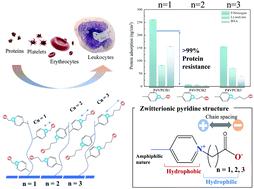当前位置:
X-MOL 学术
›
J. Mater. Chem. B
›
论文详情
Our official English website, www.x-mol.net, welcomes your feedback! (Note: you will need to create a separate account there.)
Convergent charge interval spacing of zwitterionic 4-vinylpyridine carboxybetaine structures for superior blood-inert regulation in amphiphilic phases
Journal of Materials Chemistry B ( IF 7 ) Pub Date : 2021-09-04 , DOI: 10.1039/d1tb01374b Chieh-Yang Chiu, Yung Chang, Tzu-Hao Liu, Ying-Nien Chou, Ta-Jen Yen
Journal of Materials Chemistry B ( IF 7 ) Pub Date : 2021-09-04 , DOI: 10.1039/d1tb01374b Chieh-Yang Chiu, Yung Chang, Tzu-Hao Liu, Ying-Nien Chou, Ta-Jen Yen

|
Antifouling materials are indispensable in the biomedical field, but their high hydrophilicity and surface free energy provoke contamination on surfaces under atmospheric conditions, thus limiting their applicability in medical devices. This study proposes a new zwitterionic structure, 4-vinylpyridine carboxybetaine (4VPCB), that results in lower surface free energy and increases biological inertness. In the design of 4VPCB, one to three carbon atoms are inserted between the positive charge and negative charge (carbon space length, CSL) of the pyridyl-containing side chain to adjust hydration with water molecules. The pyridine in the 4VPCB structure provides the hydrophobicity of the zwitterionic functional group, and thus it can have a lower free energy in the gas phase but maintain higher hydrophilicity in the liquid phase environment. Surface plasmon resonance and confocal microscopy were used to analyze the antiprotein adsorption and anti-blood cell adhesion properties of the P4VPCB brush surface. The results showed that the CSL in the P4VPCB structure affected the biological inertness of the surface. The protein adsorption on the surface of P4VPCB2 (CSL= 2) is lower than that on the surfaces of P4VPCB1 (CSL = 1) and P4VPCB3 (CSL = 3), and the optimal resistance to protein adsorption can be reduced to 7.5 ng cm−2. The surface of P4VPCB2 can also exhibit excellent blood-inert function in the adhesion test with various human blood cells, offering a potential possibility for the future design of a new generation of blood-inert medical materials.
中文翻译:

两性离子 4-乙烯基吡啶羧基甜菜碱结构的收敛电荷间隔间距在两亲相中具有优异的血液惰性调节
防污材料在生物医学领域是必不可少的,但它们的高亲水性和表面自由能在大气条件下会引起表面污染,从而限制了它们在医疗器械中的应用。本研究提出了一种新的两性离子结构,即 4-乙烯基吡啶羧基甜菜碱 (4VPCB),可降低表面自由能并增加生物惰性。在4VPCB的设计中,在含吡啶基侧链的正电荷和负电荷(碳空间长度,CSL)之间插入一到三个碳原子来调节与水分子的水合。4VPCB结构中的吡啶提供了两性离子官能团的疏水性,因此它可以在气相中具有较低的自由能,但在液相环境中保持较高的亲水性。表面等离子共振和共聚焦显微镜用于分析P4VPCB刷表面的抗蛋白吸附和抗血细胞粘附特性。结果表明,P4VPCB结构中的CSL影响了表面的生物惰性。P4VPCB2 (CSL= 2) 表面的蛋白质吸附低于 P4VPCB1 (CSL = 1) 和 P4VPCB3 (CSL = 3) 表面的蛋白质吸附, 蛋白质吸附的最佳阻力可降至 7.5 ng cm-2。P4VPCB2表面在与各种人体血细胞的粘附试验中也能表现出优异的血液惰性功能,为未来新一代血液惰性医用材料的设计提供了潜在的可能。
更新日期:2021-09-20
中文翻译:

两性离子 4-乙烯基吡啶羧基甜菜碱结构的收敛电荷间隔间距在两亲相中具有优异的血液惰性调节
防污材料在生物医学领域是必不可少的,但它们的高亲水性和表面自由能在大气条件下会引起表面污染,从而限制了它们在医疗器械中的应用。本研究提出了一种新的两性离子结构,即 4-乙烯基吡啶羧基甜菜碱 (4VPCB),可降低表面自由能并增加生物惰性。在4VPCB的设计中,在含吡啶基侧链的正电荷和负电荷(碳空间长度,CSL)之间插入一到三个碳原子来调节与水分子的水合。4VPCB结构中的吡啶提供了两性离子官能团的疏水性,因此它可以在气相中具有较低的自由能,但在液相环境中保持较高的亲水性。表面等离子共振和共聚焦显微镜用于分析P4VPCB刷表面的抗蛋白吸附和抗血细胞粘附特性。结果表明,P4VPCB结构中的CSL影响了表面的生物惰性。P4VPCB2 (CSL= 2) 表面的蛋白质吸附低于 P4VPCB1 (CSL = 1) 和 P4VPCB3 (CSL = 3) 表面的蛋白质吸附, 蛋白质吸附的最佳阻力可降至 7.5 ng cm-2。P4VPCB2表面在与各种人体血细胞的粘附试验中也能表现出优异的血液惰性功能,为未来新一代血液惰性医用材料的设计提供了潜在的可能。


























 京公网安备 11010802027423号
京公网安备 11010802027423号